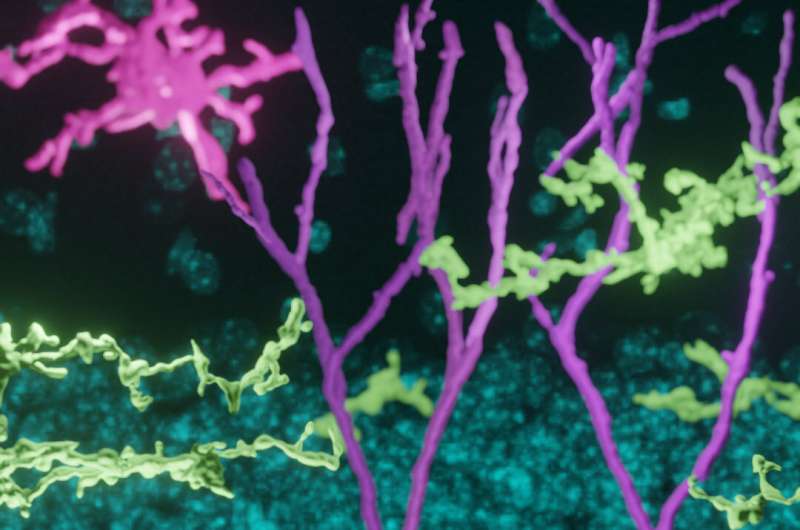This article has been reviewed according to Science X's editorial process and policies. Editors have highlighted the following attributes while ensuring the content's credibility:
fact-checked
peer-reviewed publication
trusted source
proofread
Scientists enhance new neurons to restore memory, elevate mood in Alzheimer's disease research model

In adult human brains, the hippocampus generates new neurons (adult-born neurons, or ABNs) throughout life, helping us maintain memories and regulate emotions. Scientists call this process "adult hippocampus neurogenesis (AHN)." In people with Alzheimer's disease (AD), this process is impaired, leading to reduced production of ABNs with poorer qualities. Given that AD patients often develop both cognitive symptoms (such as memory loss) and non-cognitive symptoms (such as anxiety and depression) for which AHN plays a critical role, one way to help Alzheimer's patients achieve symptom relief could be to restore AHN.
Published in the journal Cell Stem Cell,
research from UNC School of Medicine scientists demonstrated that stimulating a brain region called Supramammilary nucleus (SuM) located in the hypothalamus effectively enhanced adult-born neurons in the otherwise impaired Alzheimer's brains of mice. After patterned stimulation of SuM, AD brains developed more ABNs with improved qualities. Importantly, activation of these SuM-modified ABNs restored both cognitive and affective deficits in AD mouse models. "It's been a longstanding question whether AHN can be sufficiently enhanced in impaired AD brains to improve
By manipulating a small number of ABNs in the AD brain, we demonstrate that ABNs can be enhanced even in the presence of AD pathology, and these enhanced ABNs are important for the restoration of behaviors and hippocampal function."
To enhance ABNs in AD brains, Song and colleagues adopted an elegant two-step ABN-enhancing strategy by first stimulating SuM using a patterned optogenetic paradigm with the goal of promoting the generation and developmental properties of ABNs, followed by stimulating the activity of SuM-enhanced ABNs using chemogenetics.
Optogenetics involves the use of light to alter the activity of brain cells expressing light-sensitive opsin genes. Chemogenetics involves the use of inert molecules to alter the activity of brain cells expressing designer's receptors.
"Interestingly, SuM stimulation alone or activation of ABNs without SuM stimulation failed to restore behavioral deficits in AD mice." Song said. "These results suggest that multi-level enhancement of ABNs—namely increasing their number, improving their developmental properties, and enhancing their activity—is required to achieve their therapeutic benefits in AD brains."
When Song and colleagues further analyzed the protein changes in the hippocampus of AD mice in response to activation of SuM-enhanced ABNs, the researchers found that several well-known protein pathways were activated inside cells. These pathways include the ones important for synaptic plasticity of neuronal cells that allow enhanced communication among them, as well as the ones important for phagocytosis of non-neuronal microglia that allow efficient plaque clearance.
"It is striking that multi-level enhancement of ABNs through combined SuM and ABN stimulations allows such a small number of ABNs make profound functional contribution in diseased AD brains," Song said. "We are eager to find out the mechanisms underlying these beneficial effects mediated by activation of SuM-enhanced ABNs on AD pathology and hippocampal function. Future efforts will be needed to develop drugs that mimic these beneficial effects mediated by activation of SuM-enhanced ABNs. Ultimately, the hope is to develop first-in-class, highly targeted therapies to treat AD and related dementia."
Co-first authors of the Cell Stem Cell paper are Ya-Dong Li and Yan-Jia Luo in the Song Lab. Other authors are, Ling Xie, Dalton Tart, Ryan N Sheehy, Libo Zhang, and Leon G Coleman Jr, all at the UNC School of Medicine.
More information: Ya-Dong Li et al, Activation of hypothalamic-enhanced adult-born neurons restores cognitive and affective function in Alzheimer's disease, Cell Stem Cell (2023). DOI: 10.1016/j.stem.2023.02.006
Journal information: Cell Stem Cell
Provided by University of North Carolina Health Care





















